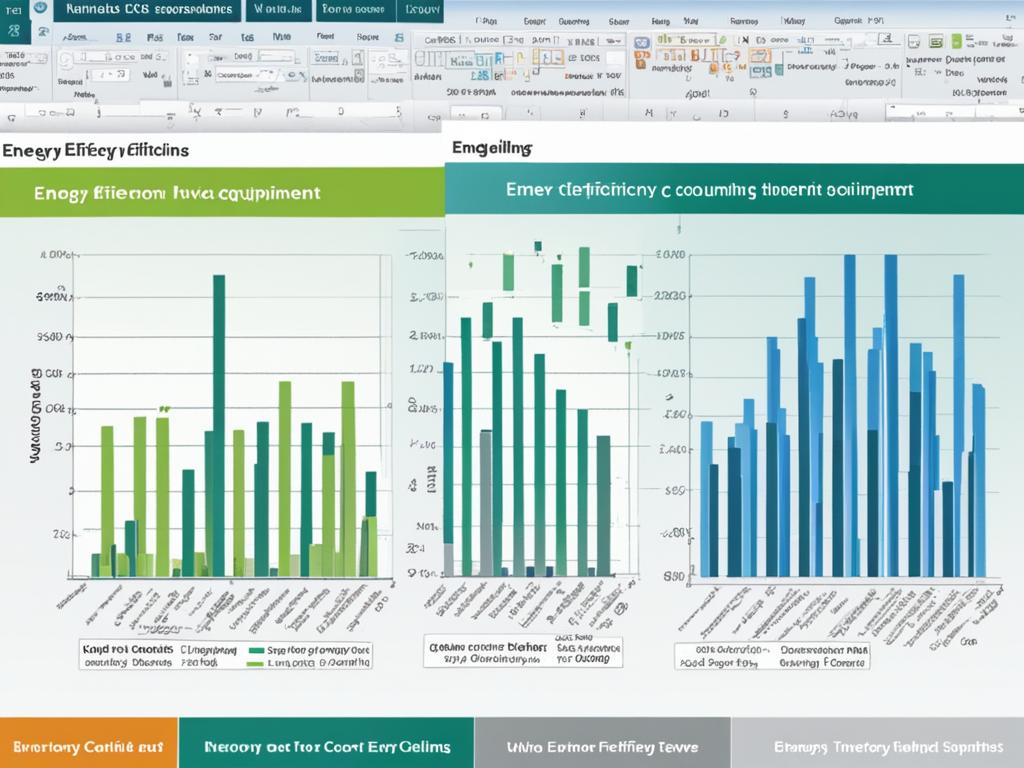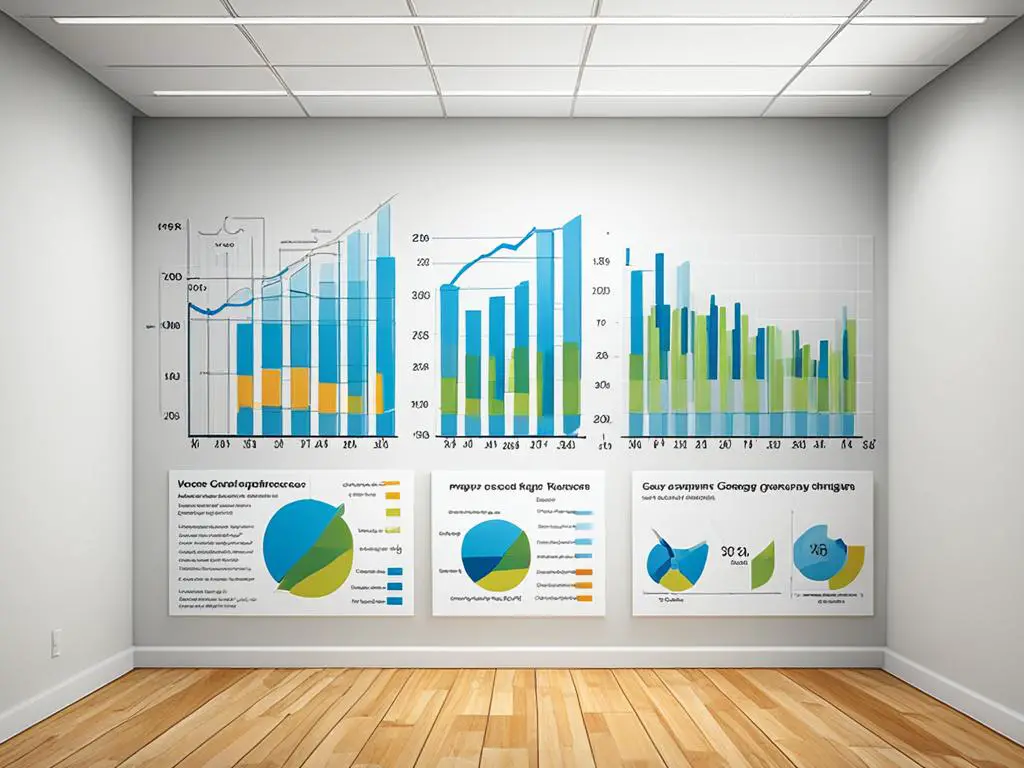When choosing between 8-foot and 9-foot ceilings for your home, it’s important to consider the impact on energy use. The ceiling height can affect heating efficiency, cooling efficiency, and overall energy consumption. Let’s explore the factors to consider when comparing the energy use of 8-foot and 9-foot ceilings.
- The height of your ceilings can affect energy consumption in your home.
- Higher ceilings may lead to increased heating costs.
- 9-foot ceilings may offer cooling efficiency advantages.
- HVAC equipment sizing should be considered for optimal performance.
- Strategies like using ceiling fans can help mitigate the impact of high ceilings on energy use.
Factors Affecting Heating Efficiency
When it comes to energy efficiency, the height of your ceiling plays a crucial role in determining heating efficiency and overall energy consumption. In this section, we will explore the factors that impact heating efficiency in relation to different ceiling heights, specifically comparing 8-foot and 9-foot ceilings.
Higher ceilings, such as 9-foot ceilings, can have implications for heating efficiency and energy savings. Due to the increased vertical space, the hot air produced by your heating system will naturally rise and settle at the ceiling. As a result, to achieve comfortable temperatures throughout the room, your furnace will need to run for longer durations, consuming more energy in the process.
With 9-foot ceilings, the heat from your heating system has a larger space to fill before it reaches the occupants. This can lead to uneven heating distribution and may result in a less efficient use of energy. On the other hand, 8-foot ceilings allow for a more direct flow of warm air from the heating system, resulting in more effective and efficient heat distribution.
Let’s take a closer look at the energy use analysis for 8-foot and 9-foot ceilings:
| Ceiling Height | Heating Efficiency | Energy Consumption |
|---|---|---|
| 8 feet | Optimal | Lower |
| 9 feet | Reduced | Higher |
The table above summarizes the key differences in heating efficiency and energy consumption between 8-foot and 9-foot ceilings. While 9-foot ceilings may offer aesthetic appeal and a sense of spaciousness, they can result in increased energy usage and higher heating costs compared to 8-foot ceilings. It’s important to consider these energy efficiency factors when making decisions about ceiling height during home construction or renovation.

Overall, the height of your ceiling can significantly impact heating efficiency and energy consumption. It’s essential to evaluate the trade-offs between aesthetics and energy-saving benefits when selecting the appropriate ceiling height for your home.
Impact on Cooling Efficiency
When it comes to cooling efficiency, higher ceiling heights can have an impact on energy consumption. The increased height of 9-foot ceilings compared to 8-foot ceilings means that the volume of air requiring cooling is greater. As a result, this may lead to the need for a larger air conditioning unit to effectively cool the space.
However, taller ceilings also offer energy-saving potential. With higher ceilings, any heat present in the room tends to stay further up. This reduces the need for the AC system to run as often, resulting in lower energy consumption.
The impact on cooling efficiency may vary depending on the specific circumstances of the home, such as insulation, windows, and overall airflow. It’s essential to consider these factors when considering the energy efficiency considerations for ceiling heights.

HVAC Equipment Sizing
When considering the energy efficiency impacts of ceiling height, it is essential to evaluate how it affects the sizing of HVAC equipment. The volume of air that needs to be heated or cooled is directly influenced by the ceiling height, making it a crucial factor in determining the appropriate HVAC units for a home. In the case of higher ceilings, such as 9-foot ceilings compared to 8-foot ceilings, the increased volume of air requires larger HVAC systems to efficiently maintain optimal performance.
This means that if you have 9-foot ceilings instead of 8-foot ceilings, you may need a larger furnace and air conditioner to meet the heating and cooling requirements of your home. However, it is important to note that larger HVAC equipment can result in higher upfront costs as well as potentially higher energy consumption.
Let’s take a look at a comparison table showing the typical energy consumption of 8-foot and 9-foot ceilings in relation to HVAC equipment sizing:
| 8-Foot Ceilings | 9-Foot Ceilings | |
|---|---|---|
| HVAC Equipment Size | Standard | Larger |
| Upfront Costs | Lower | Higher |
| Energy Consumption | Comparatively lower | Potentially higher |
This table provides a concise overview of the key considerations when comparing energy efficiency and HVAC equipment sizing for different ceiling heights. While larger HVAC units may be necessary for homes with higher ceilings, it is important to assess the cost and potential energy consumption implications before making a decision.

By carefully evaluating the energy efficiency considerations associated with differing ceiling heights, homeowners can make informed decisions regarding HVAC equipment sizing, upfront costs, and long-term energy consumption.
Mitigating the Impact of High Ceilings
When it comes to high ceilings and their potential impact on energy consumption, there are several strategies that homeowners can employ to optimize energy efficiency. By implementing these measures, you can enjoy the energy-saving benefits of 9-foot ceilings while minimizing their energy efficiency factors.
1. Utilize Ceiling Fans
One effective way to mitigate the impact of high ceilings is to utilize ceiling fans. These fans can help circulate air throughout the room, improving comfort levels and reducing the reliance on heating and cooling systems. During the winter months, ceiling fans can be set to rotate clockwise at a low speed, which helps push warm air down from the ceiling and distribute it evenly throughout the room. This can ultimately help reduce the energy required for heating your space.
2. Install Additional Supply Vents
To enhance heating and cooling efficiency, consider installing additional supply vents near the ceiling. These vents help direct airflow downward, ensuring that conditioned air is distributed evenly throughout the room. By delivering heated or cooled air closer to where occupants are located, you can create a more comfortable environment and reduce the strain on your HVAC system.
3. Implement Zone-Control Systems
If you have specific areas in your home with high ceilings, implementing a zone-control system can provide even greater energy-saving benefits. This system allows you to independently control the temperature in different zones or rooms, including those with higher ceilings. By customizing the temperature settings based on occupancy and comfort requirements, you can optimize energy use and avoid over-conditioning areas that may not need it.
By incorporating these strategies into your home design or renovation plans, you can effectively mitigate the energy efficiency impacts of high ceilings. Not only will you be able to enjoy the aesthetic appeal of taller ceilings, but you can also achieve greater energy savings and reduce the strain on your HVAC systems.
Remember, it’s important to consider the specific factors and characteristics of your home when determining the most suitable strategies for mitigating the impact of high ceilings. Consulting with a professional HVAC specialist can help you make informed decisions and optimize energy efficiency.
Conclusion
When it comes to the energy efficiency of different ceiling heights, the choice between 8-foot and 9-foot ceilings can have a significant impact. Higher ceilings, such as 9-foot ceilings, can result in increased energy consumption, especially for heating purposes. However, they may offer benefits in terms of cooling efficiency. It is important to weigh the advantages and disadvantages before making a decision.
Additionally, the sizing of HVAC equipment should be taken into consideration. Homes with higher ceilings may require larger furnaces and air conditioners to maintain optimal performance. This may lead to higher upfront costs and potentially higher energy consumption in the long run.
Fortunately, there are strategies available to mitigate the impact of high ceilings on energy consumption. Homeowners can use ceiling fans to improve air circulation and optimize comfort, particularly during the winter months. Installing additional supply vents near the ceiling can also help direct airflow and enhance the efficiency of heating and cooling systems. Furthermore, considering a zone-control system can provide independent temperature control in areas with high ceilings, further optimizing energy use.
In conclusion, the choice between 8-foot and 9-foot ceilings should consider personal preferences, budget limitations, and overall energy efficiency goals. While higher ceilings may offer certain advantages, such as improved cooling efficiency, they also pose challenges in terms of heating and HVAC equipment sizing. By implementing strategies to mitigate the impact of high ceilings, homeowners can potentially achieve energy savings and create a comfortable living environment.
FAQ
How do 8-foot and 9-foot ceilings compare in terms of energy use?
The ceiling height can affect heating efficiency, cooling efficiency, and overall energy consumption. Higher ceilings can result in increased energy consumption for heating, but they may offer benefits in terms of cooling efficiency.
What factors affect heating efficiency with different ceiling heights?
With 9-foot ceilings compared to 8-foot ceilings, the hot air from your heating system will rise and settle at the ceiling, requiring the furnace to run longer to distribute enough warm air throughout the room.
How do higher ceilings impact cooling efficiency?
While the increased height of 9-foot ceilings may require a larger air conditioning unit to effectively cool the space, the higher ceilings also allow any heat in the room to stay further up, reducing the need for the AC system to run as often. The overall impact on cooling efficiency may vary.
How does ceiling height affect HVAC equipment sizing?
Homes with higher ceilings require larger HVAC units to maintain optimal performance due to the greater volume of air that needs to be heated or cooled. This can result in higher upfront costs and potentially higher energy consumption.
What can be done to mitigate the impact of high ceilings on energy consumption?
Strategies such as using ceiling fans to improve air circulation and installing additional supply vents near the ceiling can help optimize heating and cooling efficiency. Considering a zone-control system to independently control the temperature in areas with high ceilings can also be beneficial.
What should be considered when deciding between 8-foot and 9-foot ceilings?
When making a decision, it’s important to consider personal preferences, budget, and overall energy efficiency goals. Higher ceilings can lead to increased energy consumption for heating, but they may offer benefits in terms of cooling efficiency. Implementing strategies to mitigate the impact of high ceilings can potentially lead to energy savings.



